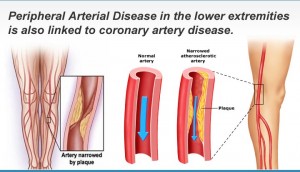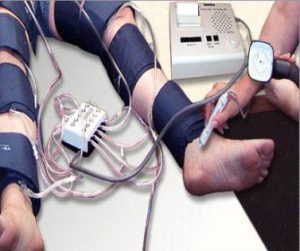Peripheral Arterial Disease
Peripheral arterial disease is a circulatory problem in which narrowed arteries reduce blood flow to the limbs. Many times it is  the legs that don’t receive enough blood flow. Walking can cause leg pain. A person with significant peripheral arterial disease typically develops pain in the muscles of the calf or thigh after walking a certain distance and beings to limp and then stops walking due to the pain. The limping is called claudication. Peripheral artery disease can be treated by stopping smoking, exercising and eating healthy.
the legs that don’t receive enough blood flow. Walking can cause leg pain. A person with significant peripheral arterial disease typically develops pain in the muscles of the calf or thigh after walking a certain distance and beings to limp and then stops walking due to the pain. The limping is called claudication. Peripheral artery disease can be treated by stopping smoking, exercising and eating healthy.  Sometimes, a blood thinning medication called Coumadin is prescribed for treatment. If a person is on Coumadin, then they must be very careful never to take too much. If a person were cut while on Coumadin, they have a risk of bleeding to death. Therefore, this would tend to affect the type of jobs they could do. This is a significant limitation and needs to be presented to the Social Security Administration during a hearing. When presenting the case to the Social Security Administration, it is important to submit evidence of arteriograms and Doppler studies.
Sometimes, a blood thinning medication called Coumadin is prescribed for treatment. If a person is on Coumadin, then they must be very careful never to take too much. If a person were cut while on Coumadin, they have a risk of bleeding to death. Therefore, this would tend to affect the type of jobs they could do. This is a significant limitation and needs to be presented to the Social Security Administration during a hearing. When presenting the case to the Social Security Administration, it is important to submit evidence of arteriograms and Doppler studies.
What Our Clients Say:
Member:

Attorney Gregory Kornegay
Greg is a trial attorney in Wilmington with over 30 years of experience. Greg was born and raised in southeastern North Carolina. Before law school he managed a store with employees making a payroll every week. His first job out of law school was as an Assistant District Attorney investigating and trying cases for the State of North Carolina. Through the years he has handled many different types of cases – including death penalty cases.
Being married with children has been a blessing and a challenge, but has served him well in understanding the problems individuals and families face as they live out their lives. Greg believes that each case is different and the needs of each client are unique, but there are certain themes of life that we all share.


